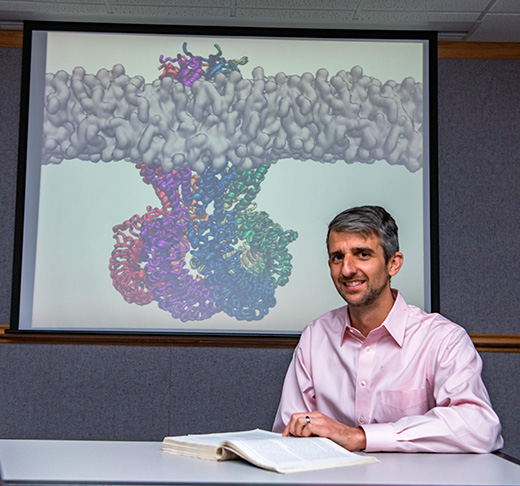Comer's CAREER grant a first for College of Veterinary Medicine
Thursday, June 18, 2020

Jeff Comer, associate professor of anatomy and physiology, is the first faculty member ever from the Kansas State University College of Veterinary Medicine to receive a National Science Foundation CAREER award. | Download this photo.
MANHATTAN — A Kansas State University researcher is the first in the College of Veterinary Medicine to receive a CAREER award from the National Science Foundation.
Jeff Comer, associate professor of anatomy and physiology, has received a $450,513 award from the NSF Faculty Early Career Development, or CAREER, Program. The grant period is for five years. Depending on funding availability and scientific progress of his project, funding could be increased by $115,344 in the fifth year, bringing the total of the award to $565,857.
The CAREER program offers the NSF's most prestigious awards in support of early-career faculty who have the potential to serve as academic role models in research and education, and to lead advances in the mission of their department or organization.
"The NSF CAREER program is different from other NSF grants in that it is not only a research grant but also is meant for academic career development of the faculty," Comer said. "As such, it includes a substantial educational component along with the research."
"Dr. Comer works at the intersection of biology, physics and mathematics," said Hans Coetzee, professor and head of the anatomy and physiology department. "His groundbreaking research uses innovative computational methods to solve contemporary biological problems. He has leveraged these skills to establish productive interdisciplinary collaborations with many of our faculty with a traditional biomedical research focus. We are fortunate to have Dr. Comer at K-State and we are proud of his recent NSF award."
The CAREER award funds Comer's research using computer simulations and complementary experiments to design protein-like molecules that can easily be programmed to arrange themselves into complex devices for biomedical applications such as diagnostic tests.
"The miniaturization of devices such as computers and cellphones has been so successful that the size of their parts is now similar to the size of molecules and atoms," Comer said. "Soon, the old ways of building things will no longer work. The future is building things out of individual molecules. It is as if we are going from building sandcastles to building tiny castles out of individual grains of sand."
His research team also seeks to develop computer simulations of molecules for use in college classrooms and in K-12 outreach. These simulations will give students a better understanding of how molecules move.
"The interactive simulations will be aimed at helping students understand how medicines work and how new medicines can be designed," Comer said. "The educational modules and simulation programs will be made freely available to educators and the public, and will include English- and Spanish-language versions."
